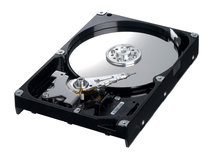Solve disk slowdown

Even if you delete files on a regular basis and are good at managing the files on your disk, you will usually find that disk access slows down over time.
One of the main causes of this is the filing system you're using. With Windows XP, Microsoft encouraged users to switch from FAT32 to NTFS. FAT32 is a pretty basic filing system, which becomes easily fragmented and therefore needs defragmenting on a regular basis.
The reason for this fragmentation is that when new data is written to the disk, it is placed wherever there is a hole in the file order big enough to accommodate it. This means that files quickly become spread out all over the disk.
In order to find free space for a file, the entire File Allocation table has to read, linearly, which severely degrades performance on large disks. Regular defragmentation will put data back into contiguous blocks, and move it to the start of the File Allocation table, thereby increasing your system's performance. NTFS is a much more advanced filing system that is able to reserve space, as well as supporting metadata. File locations are stored in the Master File Table (MFT).
One of the major changes between NTFS and FAT32 is that with NTFS, a file is stored with a number of attributes. However, the size of each record in the MFT is limited, generally equal to the cluster size of that particular volume. If a file is smaller than this cluster size, both it and its attributes can be stored in the MFT. However, if a file is larger than the cluster size, some of the data is moved out and stored in additional MFT records. Should the file continue to grow, additional records may be created, which equates to a nested series of records and pointers.
Room to grow
In addition, the NTFS filesystem deliberately places space around files to allow for expansion. However, if the files don't grow, this space isn't used, and if the files grow too much, then the data has to be written to a new area on the disk. So, while NTFS might be more efficient than FAT32 in terms of data lookup, it's still just as susceptible to physical fragmentation. This causes the disk read/write head to move about more, which of course decreases performance. This means that NTFS drives should also be defragmented on a regular basis.
Sign up for breaking news, reviews, opinion, top tech deals, and more.
The built-in defragmenter in Windows is basic at best, and it's usually best to use a third-party alternative. One of the tools you can try is Contig, from Sysinternals. It's a command-line tool that attempts to make files contiguous on disk. If you prefer a GUI front-end, we suggest you use Power Defragmenter.
Help decrease hard disk access times:
1. Use a Disk Cleanup wizard
The Disk Cleanup wizard can be used to remove all sorts of temporary files, error reports and other files that you no longer need. It couldn't be more easy to use: simply tick the items that you want to clean and let the wizard work its magic.
2. System Restore points
You can also use the Disk Cleanup tool to remove all but the last System Restore point. Deleting the System Restore points can free up a large amount of space. Programs you never use can also be removed.
3. Try CCleaner
CCleaner does a wonderful job at not only removing files that the Disk Cleanup wizard may have missed, but it will also uninstall software for you. You can use CCleaner to remove invalid entries from the Registry, too.
-------------------------------------------------------------------------------------------------------
First published in PC Plus, Issue 278
Now read The ultimate guide to overclocking
Sign up for the free weekly TechRadar newsletter
Get tech news delivered straight to your inbox. Register for the free TechRadar newsletter and stay on top of the week's biggest stories and product releases. Sign up at http://www.techradar.com/register